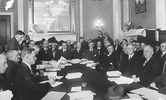One of Norman Rockwell's Four Freedoms paintings used as wartime posters, first coming out in 1943. They were based on his prewar January 1941 speech advocating for these freedoms. At the time of the speech, and certainly at the time of the war, a lot of people didn't have a freedom from want.
In some prior years I've put up a Thanksgiving Day post. Some years, I don't.
There's a lot of hubris in writing a blog, a principal part of that being the thoughts that 1) you have anything meaningful to say; and 2) anyone cares to read it. In large part, probably neither of those are true, so no blogger should feel compelled to write an entry. Still, some years. . .
For a lot of people, this will be a Thanksgiving like no other. Well, rather, like no other one that that we recall. There are certainly plenty of North American Thanksgivings that more strongly resemble this one than we might imagine. *
After all, the holiday was already fully established as a European religious observation long before the passengers of the Mayflower put in early as they were out of beer (which is in fact why they put in when they did). We might imagine those early Thanksgiving celebrants looking like they were out of a Rockwell or Leyendecker illustration, but they likely rarely did.
Clean parents, chubby child. . . probably not very accurate for the early colonial period. Carrying a matchlock on the way to church might be however, and not because they were going to hunt turkeys on the way home. Illustration by J. C. Leyendecker from November 1917.
Indeed, a lot of the giving of thanks on days like this from prior eras was probably of a much more to the bone nature. The crop didn't fail, when it looked like it might. The milk cow didn't bloat up and die. The Algonquian's simply walked by the village a couple of months ago when it looked like they might attack. That ship on the horizon wasn't a French one and no Troupes de Marne landed to raise the district. The Spanish didn't arrive from the south.
Freedom from Fear. For much of human history, most people lived in fear for at least some of the time.
Part of all of that, on top of it, was dealing with political and physical turmoil.
Smallpox arrived and went leaving people, if they were lucky, scarred for live. The flu came and when it did people died nearly every time. Horses kicked people in the ribs and they died in agony a few days later. Dog and cat bites turned septic. Tooth infections were caught too late causing fevers that went right to the brain and then on to death.
Storms came with only hours, or minutes, warning. Hurricanes arrived with no notice. Tornadoes ripped through villages at random. Hail destroyed crops. Early winters froze the crops in the ground. Spring thaws came suddenly and swept animals, houses, and people away. Snow blocked travel and locked people who still had to work outdoors during the winter indoors. People got lost, and then were lost forever. Seafarers disappeared in winter storms and were never heard of again, or if they were they were, their washed up bodies were identified by the patterns in their wool sweaters, unique to individual villages, like dog tags of their day.
And added to that, there was the additional turmoil of vast struggles beyond people's control. Catholics lived in fear of oppression from Protestants. Protestant dissenters lived in fear of the Established Church. Jews lived in fear of everyone. Forces in England struggled against the Crown and each other and their fights spilled out to their colonies. Native Americans lived in fear of a European population of an expansive nature that seemed to defy the laws of nature. Africans lived in fear of slavers and if that fate befell them they thereafter lived in lifelong despair.
Freedom of Worship. Even this American value didn't come about until the scriveners of the Constitution prevented the United States from creating a state religion. At the time of the Revolution the Congress had declared the Crown's tolerance of Catholicism in Quebec one of the "Intolerable Acts". As late as the Civil War Gen. Grant's General Order No. 11 targeted Jews.
The point is, I guess, that our ancestors endured all of this and made it.
Of course, they endured it better sometimes than in others. When they lost the ability to at least get along, things got very bad indeed. The most notable example, probably, came in 1860 to 1865 when Americans had reached the point where their differences could only be solved violently.
When those things got that way, one notable thing was the fragility of civility, order and even common sense. In bad times Americans have done well if their leaders had a vision, even if disagreed with, and were clear about it, even if the opposition was distinct in that opposition. A key to it was an overall sense that we were all in this together in spite of those differences. The US did well as a society in the Great War, even with lots of failings, as it generally agreed with Wilson that something needed to be done in Europe and we had to do it, and even if we disagreed with that, we were all Americans and weren't going to send just our neighbor off to fight. We did very well in World War Two uniting behind Franklin Roosevelt and Harry Truman on the concept that we were a democratic nation, united by that, and we were going to bring those values to a world that had forgotten them, even if some wished the war hadn't ever come. We did pretty well in the Cold War, with the exception of some real distress in the late 40s and early 50s, and again in the late 60s and early 70s, with the idea that we were freedom's sentinel, even if we didn't always like what that meant.
Right now, we're a mess.
We are not united on anything, and we've politicized everything. And our polarization is massive.
We've been polarized of course before, but it's been sometime since we were this split, or so it would seem. Some would argue that we're really not, and that most are in the middle.
If we aren't mostly in the middle, the problem then becomes the point at which we arrive at a point at which we not only aren't, but we've reached the state where the polarized sides only see forcing their view at all costs upon the other as the solution.
Advanced nations have had that happen before. Weimar Germany lived in a state of being that started off that way in 1918 and dissolved due to that in 1932. It wasn't that there were not right wingers who valued democracy over force, or that there were not left wingers who valued democracy over force, but rather that people quit listening to them and opted for the parties that promised to force their views with dominating finality.
That is, of course, sort of what happened in 1860 to us, when one side decided that it had to have its way so much that it would leave to get it, and kill to maintain it.
Surely we're not there yet. But one thing we are is fatigued. And that's not a good thing. A lot of people have just had enough. They're worn down by the Pandemic. They're tired of politicians. They don't want to hear anymore. It's not that they're disinterested.
They're tired.
So perhaps we can look back on those early North American Thanksgivings here a bit. The crops didn't fail. The North Koreans didn't attack South Korea. The Chinese didn't invade Taiwan. The Russians didn't suddenly decide they wanted Poland back.
And yes, a lot of us fell ill, some will never fully recover, and some have died. That will continue on. But as tragic as that is, we've had their better times and our prior health, and as grim as it is, it serves as a reminder that our path through here is temporary, and if, in the words of the old country song, we "don't have a home in this world anymore", well we never had a perfect one.
Freedom of speech, something which most people have not had except on a local level since at least the point at which society became advanced, but which is an American hallmark.
Related threads:
*Thanksgiving isn't really a North American holiday any more than its just an American one, in the larger sense, and this confusing entry here reflects that. I'm mostly referring to the United States in this entry, and the predecessor English colonies, but not exclusively, as can be seen by text above that's more applicable to other areas.


















































